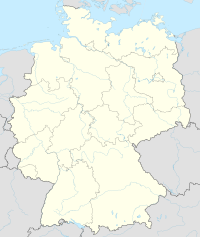Air Force Officers' College / Air Defense for Military Aviators "Otto Lilienthal"
| OHS "Otto Lilienthal" - XX - |
|
|---|---|

|
|
| activity | 1986-1990 |
| Sponsorship |
NVA , |
| place | OHS Bautzen staff |
| country |
|
| last commander | Colonel Dipl.-Mil. Rainer Langener |
| Students | k. A. |
| Employee | k. A. |
| Website | Officer school (s) of the LSK / LV |
OHS military aircraft with FAG-25 in Bautzen |
The officers' college of the air forces / air defense for military pilots (OHS for military pilots) was named Otto Lilienthal and was a military university of the GDR . It served the training of pilots and navigators, primarily of the air forces , but also of other armed forces (TSK) of the NVA , the Ministry of the Interior and Interflug .
history
The OHS for military aviators was founded in 1986. Until then, the pilots and navigators were trained at the Officers' College of the Air Force / Air Defense Franz Mehring (OHS of LSK / LV) in Kamenz . The deployment of the sections and the flying units for the training of military pilots in Bautzen, Brandenburg, Kamenz and Rothenburg remained unchanged.
In addition, the aeronautical training section in Bautzen and Brandenburg was separated from the OHS Franz Mehring and placed under the new OHS Otto Lilienthal.
The OHS maintained sponsorship relationships with the Officers' College of the Polish Air Force .
Outline and organizational structure
Management structure
The OHS for military aviation had the following governance structure.
Commander of the OHS, with secretariat management area and secretary of the "Scientific Council"
- Management bodies (staff)
- Deputy for Aviation Training (first deputy)
- Deputy and Chief of Staff
- Deputy and Head of Political Affairs
- Deputy and Head of Aviation Engineering
- Deputy and head of rear services with direct subordinate SGVE-15
- Head of subdivision management (A1, HR)
- Head of the Finance Department
- Sections
- Section 1: Social Science Education
- Section 2: General basic training
- Section 3: FA / pilot and Section 4: FA / helicopter pilot
- with group leaders / company commanders of the student officers and subject teachers / platoon leaders of the student officers
- Unit of the administration in 2000
- Training units
- Courses for student officers and ensign students in the uses:
- Fighter pilots / bomb fighter pilots, helicopter pilots, military transport pilots, crew helmsmen, ensign / 2. Helicopter operator
Higher education
The training at the OHS for military pilots was usually preceded by previous pilot training in glider and powered flight at the Society for Sport and Technology .
Based on the organizational forms of the universities and technical colleges, the training took place in sections with several different chairs . During the course of study, if the required qualifications and examination certificates were provided, classification badges , pilot level III or helmsman / flight navigator level III could be awarded.
The training to become officers of the LSK / LV took place in the specialist areas of fighter pilots, bomb fighter pilots, helicopter drivers, transport pilots and helmsmen / navigators for flying crews of transport aircraft. The designation helmsman was based on the common use in the Soviet air force helmsman of the air force ( ru: авиационный штурман , awiazionnyi sturman ).
Military aviation training
The following overview shows the development of military aviation training in the NVA air forces from 1952 to 1990.
from 1952 to 1986
|
|||||||||||||||||||||||||||||||||||||||||||||||||||||||||||||||||||||||||||||||||||||||||||||||||||||||||||||||||||||||||||||||||||||||
Fighter pilots and fighter bomb pilots
The pilot training for fighter pilots and fighter bomb pilots took place in the first and second year of study in the Fliegerausbildungsgeschwader 25 (FAG-25) at Bautzen airfield , using L-39ZO aircraft .
In the third and fourth year of study, pilot training in Fliegerausbildungsgeschwader 15 (FAG-15) at Rothenburg / Görlitz airfield was continued on MiG-21 machines .
If necessary, students in their fourth year of study could be commanded to train on Su-22 or MiG-23 machines at an officers' college in what was then the USSR .
Helicopter pilots
The flight training of the helicopter pilots took place in the first and second year of study in the helicopter training squadron 35 (HAG-35) at the Brandenburg-Briest airfield on Mi-2 helicopters. Mi-8 helicopters were used here in the third and fourth year of study .
Ensigns were also trained as second helicopter pilots / operators in the HAG-35 .
Transport plane
The entire pilot training for transport pilots took place in the transport pilot training relay 45 (TAS-45) at Kamenz airfield . In the first two academic years, training was carried out on type An-2 aircraft and in the third and fourth academic year, aircraft of the type L-410 UVP were used.
The training to become a helmsman / navigation officer was carried out on specially equipped An-2 and L-410 UVP aircraft of the TAS-45 in Kamenz up to the third year of study. The training in the fourth year of study then took place in the Transport Fliegerstaffel 24 , using transport aircraft An-26 at Dresden Airport .
Commanders
| Rank, name | period of service | comment |
|---|---|---|
| Colonel Dr. Wolfgang Thonke | 1986-1989 | later major general in the LSK / LV command |
| Colonel Dipl.-Mil. Rainer Langener | 1989-1990 |
resolution
With the decommissioning of the NVA in 1990, the officers' college was dissolved. Legal successors were the Bundeswehr Command East and the 5th Air Force Division .
literature
- Rainer Langener: My years on the ejection seat . Memories and thoughts of a GDR military aviator. Helios, Aachen 2012, ISBN 978-3-86933-078-5 .
Individual evidence
- ↑ Stories of Aviators - From Takeoff to Landing. Facts and experiences - written down by members of the NVA aviation forces, Strausberg 2013, original edition (p. 361): ISBN 978-3-9814822-3-2 , Strausberg, Berlin, 2013.

